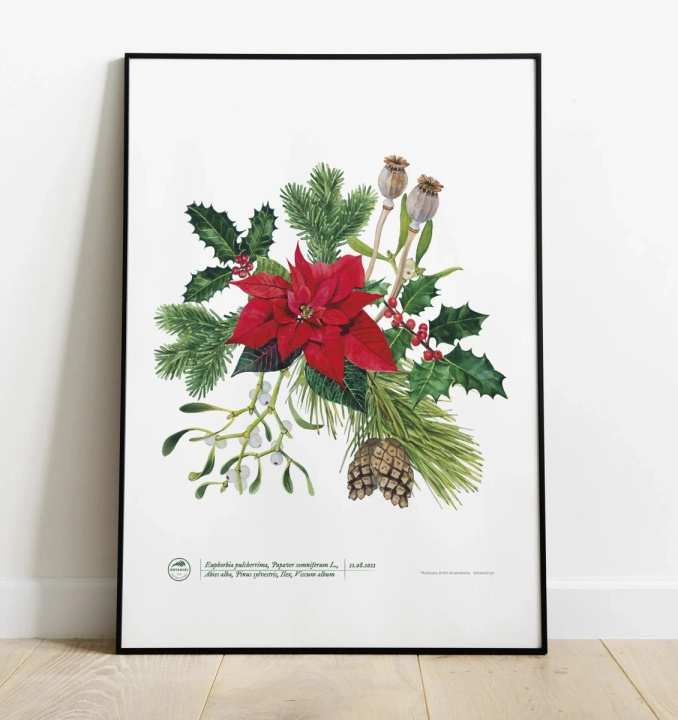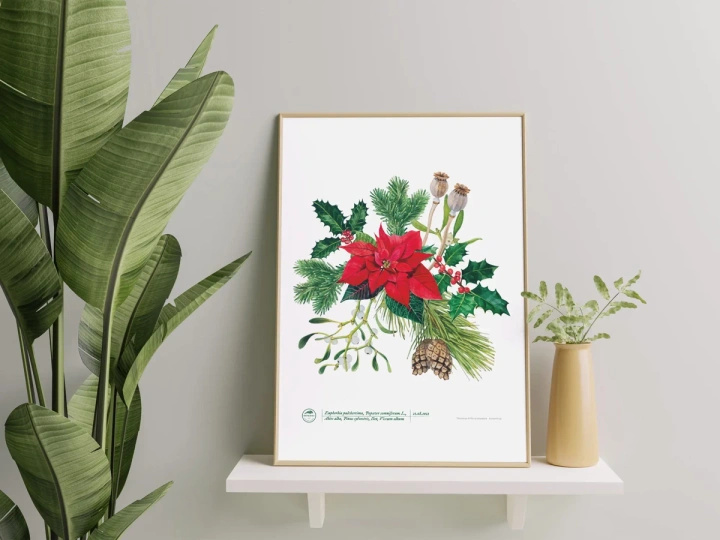Winter bouquet — plant motif poster
- Poster measuring 32 x 45 cm printed on snow-white 250 g coated paper. When framed in an antique or classic frame with passepartout it will beautifully decorate your interior. Packed flat - no unrolling required.
Subscription products in your shopping cart
Set one delivery frequency for all subscription products in your cart every:
Subscription products in your shopping cart

The natural beauty of plants suitable for any room
The poster is a simple and effective way of providing your home with beauty and elegance. The plant themes on the botaniki posters have been created by Polish artists using watercolours to achieve beautiful and colourful graphics reminiscent of old herbariums from a time before the invention of photography. Each image has been scanned, digitally processed and printed on high quality chalkboard paper to ensure vibrant and long-lasting colours.
- Dimensions: 45 x 32 cm
- Paper weight: 250 g
- Shipped flat
- Sold without a frame
- Coated paper
Winter bouquet:
Wildebeest, opium poppy, silver fir, Scots pine, holly
Euphorbia pulcherrima, Papaver somniferum L., Abies alba, Pinus sylvestris, Ilex
The proper name for the star of Bethlehem is the spurge Euphorbia pulcherrima, but it is also commonly referred to as poinsettia, or poinsettia nadobia. The plant is native to South America. Thanks to the first United States ambassador to Mexico, it got first to North America and then to Europe. It owes its attractive appearance to its pituitaries, or leaves, located just below the flower. The inflorescence itself, on the other hand, is small, unattractive and visually unappealing.
Papaver is a genus that includes both annual and biennial plants, as well as perennials. The height of the plants usually ranges from 30 to 120 cm. A distinctive feature is the fruit - a multi-seeded pouch visible after the different-colored flowers have bloomed. Poppies contain a milky sap of white to yellow color, rich in numerous alkaloids, including substances with narcotic effects. In Poland, opium poppies are grown for industrial, medicinal and also food purposes.
Mistletoe is an evergreen semi-parasite. This means that, parasitizing trees, it only takes minerals and water from them, and produces the products of photosynthesis on its own, thanks to the chlorophyll contained in its tissues. Mistletoe spreads with the help of mistletoes and passerines - birds that eat its fruits. It is widespread throughout the country, on many species of deciduous trees and is increasingly appearing on coniferous trees as well. The exceptions are native oak species, on which the hemiparasite has not been reported.
Most representatives of this genus are native to regions with cool and humid climates. They are usually mountainous trees, requiring high humidity and moderately moist, fresh soils for good growth, and cannot tolerate drought and heat. In our climate, most species are characterized by low resistance to hard frosts and spring frosts. Firs grow most beautifully in places with a moist, favorable microclimate, for example, near bodies of water, while secluded, sheltered from winds (especially eastern winds, which are most harmful to them). Firs have needles that are unsharpened at the tips and have lighter stripes of waxy coating along the underside of the needles.
Pinus includes many species from dwarf shrubs to tall and towering trees, reaching up to 70 meters in height (P. ponderosa). Within this genus, there is a division into 3 subgenera determined, among other things, by the internal structure of the needles and the number of conducting bundles. In temperate climates there are representatives of only two subgenera - Pinus and Strobus. The subgenus Strobus includes limber pine, and Pinus includes common pine. However, all representatives of the genus are united by a characteristic resinous smell, light-loving and evergreen. Pines tolerate unfavorable environmental conditions very well.
The Latin name comes from the evergreen species of oak - Quercus ilex L. There are about 400 species of this genus in the world. There are both varieties with seasonal leaves and evergreen varieties. The most common species found in Poland is holly Ilex aquifolium. It usually takes the form of a tall shrub, less often a conical tree with prickly evergreen leaves and ornamental red fruits.











